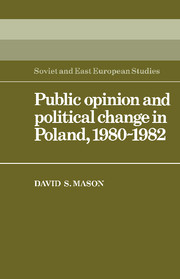Book contents
- Frontmatter
- Contents
- List of tables
- Preface
- Introduction: public opinion and politics
- 1 Public opinion research in Poland
- 2 The public and policy change in the 1970s
- 3 Values of Polish society on the eve of August
- 4 1980: causes and results
- 5 The rise and fall of Solidarity
- 6 The Party and ‘renewal’
- 7 Solidarity and the regime at the end of 1981
- 8 Martial law as a response and the response to martial law
- 9 Conclusions
- Appendix
- References
- Index
8 - Martial law as a response and the response to martial law
Published online by Cambridge University Press: 05 February 2012
- Frontmatter
- Contents
- List of tables
- Preface
- Introduction: public opinion and politics
- 1 Public opinion research in Poland
- 2 The public and policy change in the 1970s
- 3 Values of Polish society on the eve of August
- 4 1980: causes and results
- 5 The rise and fall of Solidarity
- 6 The Party and ‘renewal’
- 7 Solidarity and the regime at the end of 1981
- 8 Martial law as a response and the response to martial law
- 9 Conclusions
- Appendix
- References
- Index
Summary
‘Bez prowokowania nie ma aresztowania’ (Without provocations, there are no arrests)
Slawomir Mrożek, Policja‘You know what our people are like. One minute they come together, the other they go back home. Now they'll come back again. Maybe not four hundred straight off, maybe three hundred, maybe two hundred at the worst …’
Tadeusz Konwicki, The Polish ComplexWhen Premier and Party Secretary Jaruzelski declared a ‘state of war’ on December 13, he did so without mentioning the Polish United Workers' Party. He himself was introduced only as the head of the Military Council of National Salvation (WRON) and Premier; his title of First Secretary of the Party was not mentioned. The new military government removed the red Party flag from the Party headquarters building in Warsaw and replaced it with the red and white Polish flag. The Politburo and Central Committee did not get around to approving the martial law decree until February 24, almost a month after the Sejm had done so (Kruszewski 1984).
Jaruzelski claimed that martial law was necessary to restore stability to the marketplace and the political arena, and to preclude the possibility of civil war. The General was never very specific about how such a conflict might emerge. It might well have broken out within the Party itself. As noted in Chapter 6, there was some speculation that the apparatchiks were planning their own coup in late December (Spielman 1982, p. 32).
- Type
- Chapter
- Information
- Public Opinion and Political Change in Poland, 1980–1982 , pp. 201 - 232Publisher: Cambridge University PressPrint publication year: 1985



